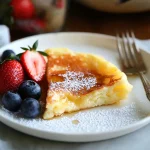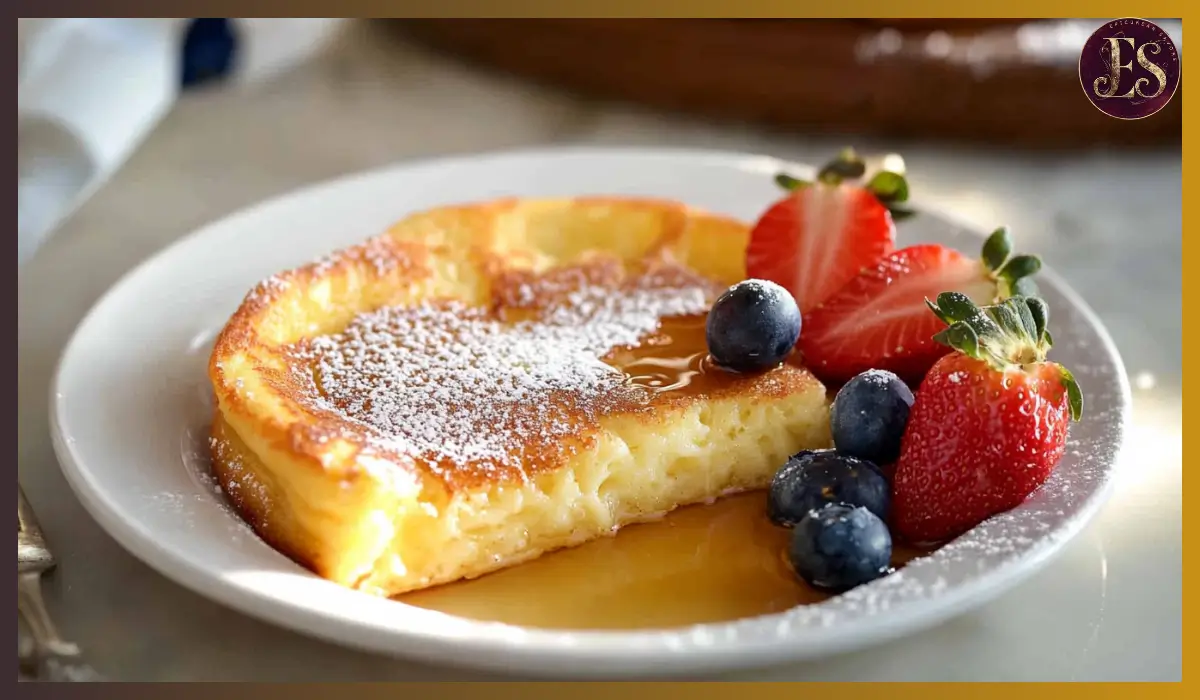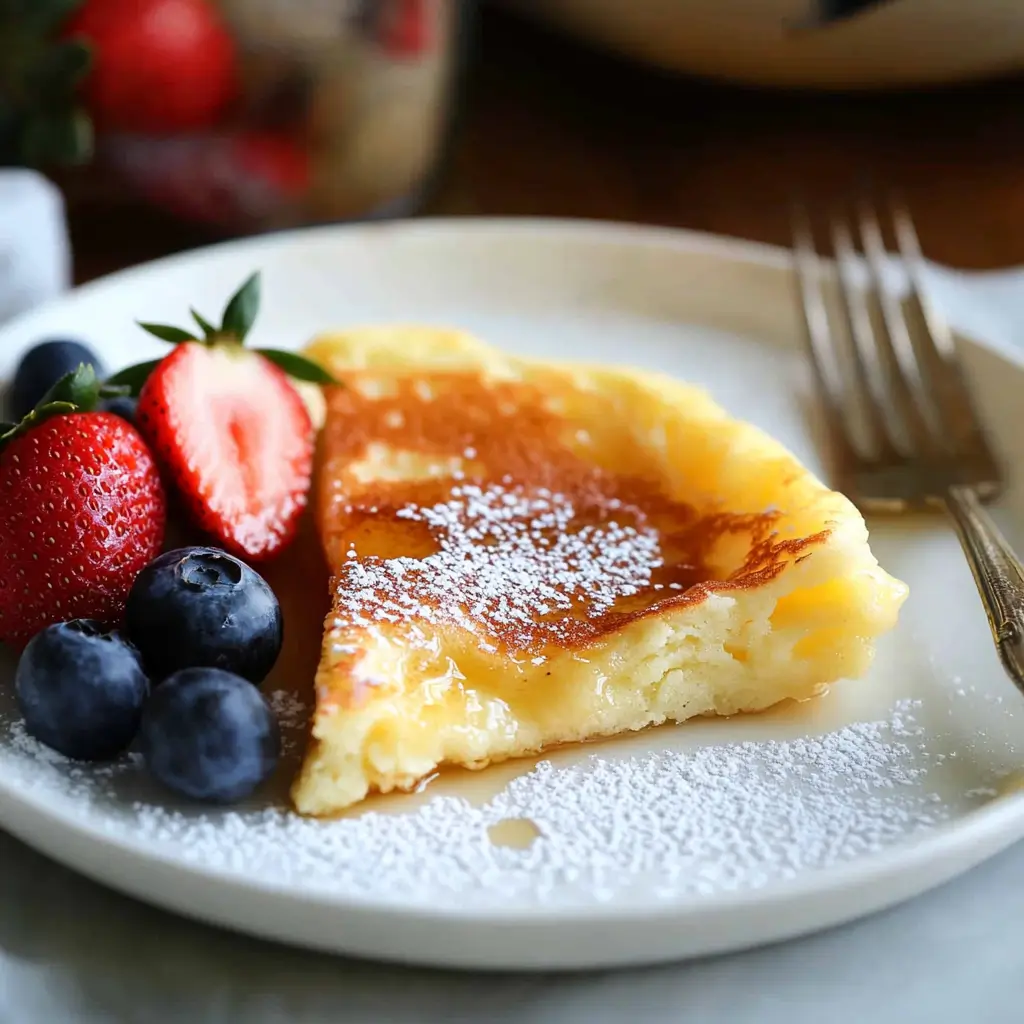There’s something almost magical about German pancakes, also known as Dutch babies. They start as a simple batter, but the moment they hit the oven, they transform into a beautifully puffy, golden creation with crispy edges and a soft, custard-like center. It’s a breakfast that feels special but is incredibly easy to make.
I remember the first time I made German pancakes. I had seen them on a food blog and was mesmerized by how they ballooned up in the oven. When I finally pulled mine out, I was delighted by their airy, cloud-like texture. My family gathered around, waiting to dig in, and within minutes, the pancake had disappeared—topped with powdered sugar, syrup, and a handful of fresh berries. From that moment on, this recipe became a weekend tradition in our house.
Unlike traditional pancakes that require flipping, these bake entirely in the oven, making them practically effortless. Whether you’re making breakfast for your family, hosting a brunch, or just craving something warm and cozy, this German pancake recipe will deliver. With only six simple ingredients and a five-minute prep time, it’s one of those recipes you’ll turn to again and again.
Plus, the best part is watching it puff up in the oven. If you have kids, they’ll love peeking through the oven door to see the magic happen. And even though the pancake deflates slightly once removed from the oven, the resulting texture is nothing short of perfect. With a delicate balance between crispy and soft, it pairs beautifully with toppings like powdered sugar, syrup, fresh fruit, and whipped cream.
Let’s dive into why this recipe is a must-try and how you can make the best German pancakes from scratch.
Why You’ll Love This Recipe
There are so many reasons to love German pancakes. First and foremost, they are incredibly easy to make. If you can whisk together a few ingredients and pour them into a pan, you can make this dish successfully. There’s no need for complicated steps, and the entire process takes less than 30 minutes from start to finish.
Secondly, the flavor and texture are unbeatable. Unlike traditional pancakes, which are dense and fluffy, German pancakes have a unique, airy structure. The edges crisp up beautifully in the oven, while the center stays soft and custard-like. This contrast in textures makes every bite incredibly satisfying.
Another reason to love this recipe is its versatility. You can keep it simple with just powdered sugar, or you can dress it up with fruit, syrup, honey, or even a drizzle of chocolate. Some people even like to make it savory by adding cheese, herbs, or crispy turkey bacon.
This recipe is also kid-friendly. Since it bakes in the oven, there’s no need to stand over a hot stove flipping pancakes. That means you can spend less time cooking and more time enjoying breakfast with your family. And if you have little ones, they will absolutely love watching the pancake rise and puff up as it bakes.
Lastly, German pancakes are perfect for special occasions and lazy weekends. Whether you’re celebrating a birthday, hosting brunch, or just want a cozy breakfast on a Saturday morning, this dish is always a hit. It looks impressive, but it’s actually one of the easiest breakfasts you can make.
Health Benefits
While German pancakes are definitely a treat, they also come with some nutritional benefits. First, the eggs in this recipe provide a great source of protein. Each serving contains about 8-10 grams of protein, which helps keep you full and satisfied. Eggs also provide important vitamins like B12, riboflavin, and selenium, which support energy levels and overall health.
Another benefit of this recipe is that it’s naturally lower in sugar compared to traditional pancakes. Since the batter itself isn’t sweetened, you have complete control over how much sweetness you add through toppings. If you prefer a healthier option, you can top your pancake with fresh fruit, Greek yogurt, or a drizzle of honey instead of syrup.
German pancakes are also made with simple, whole ingredients—milk, eggs, flour, and butter. There are no processed ingredients or additives, making it a great option if you’re trying to eat more natural foods.
Additionally, this recipe can be easily modified to fit dietary needs. You can use whole wheat flour for added fiber, almond milk for a dairy-free version, or even gluten-free flour to accommodate those with gluten sensitivities.
Because they’re baked rather than fried, German pancakes are also lower in oil than traditional pancakes. That means you get all the delicious flavor and texture without the extra greasiness.
Preparation Time, Servings, and Nutritional Information
- Preparation Time: 5 minutes
- Cooking Time: 20 minutes
- Total Time: 25 minutes
- Servings: 4-6 people
Nutritional Information (Per Serving):
- Calories: 250
- Protein: 8g
- Carbohydrates: 30g
- Fat: 10g
- Fiber: 1g
- Sugar: 4g
Ingredients List
To make this German pancake recipe, you’ll need the following ingredients:
- 6 large eggs
- 1 cup whole milk
- 1 cup all-purpose flour
- 1/2 teaspoon salt
- 1 teaspoon vanilla extract (optional, but adds great flavor)
- 2 tablespoons melted butter (for the batter)
- 2 tablespoons butter (for greasing the pan)
Optional Toppings:
- Powdered sugar
- Maple syrup or honey
- Fresh berries (strawberries, blueberries, raspberries)
- Whipped cream
- Lemon juice
Step-By-Step Cooking Instructions
Step 1: Preheat the Oven
Start by preheating your oven to 425°F (220°C). Place a 9×13-inch baking dish in the oven while it preheats. This will help the pancake rise properly when you pour in the batter.
Step 2: Blend the Batter
In a blender, combine the eggs, milk, flour, salt, vanilla extract, and melted butter. Blend for about 30 seconds until the mixture is completely smooth. If you don’t have a blender, you can whisk everything together in a bowl, but make sure there are no lumps.
Step 3: Melt Butter in the Pan
Once the oven is hot, carefully remove the baking dish and add 2 tablespoons of butter. Let it melt completely, making sure it coats the bottom of the pan. This step prevents sticking and adds a delicious buttery flavor.
Step 4: Pour the Batter and Bake
Immediately pour the batter into the hot, buttered pan. Quickly return it to the oven and bake for 20 minutes. During this time, the pancake will puff up dramatically, especially around the edges.
Step 5: Serve Immediately
Once the pancake is golden and puffy, remove it from the oven. It will start to deflate within a minute or two, which is completely normal. Dust it with powdered sugar, drizzle with syrup, or add fresh fruit on top.
How to Serve
German pancakes are best enjoyed fresh out of the oven. Here are a few serving ideas:
- Sprinkle powdered sugar on top for a simple, classic option.
- Drizzle with maple syrup, honey, or fruit preserves for added sweetness.
- Serve with fresh fruit like strawberries, blueberries, or sliced bananas.
- Add a dollop of whipped cream or Greek yogurt for extra creaminess.
- Try a squeeze of lemon juice for a slightly tangy contrast.
Pairing Suggestions
This pancake pairs well with various breakfast sides:
- Turkey bacon or chicken sausage for a savory contrast.
- Scrambled or fried eggs for additional protein.
- A smoothie or fresh juice to add a refreshing touch.
- A hot cup of coffee or tea for a warm, comforting meal.
Storage, Freezing & Reheating Instructions
While German pancakes are best enjoyed fresh, you can store leftovers for later. Here’s how to properly store, freeze, and reheat them while keeping their texture and flavor intact.
How to Store Leftover German Pancakes
If you have leftovers, let the pancake cool completely before storing it. Place the pieces in an airtight container or wrap them tightly in plastic wrap. Store them in the refrigerator for up to 3 days. Keeping them covered will prevent them from drying out and absorbing other odors from the fridge.
How to Freeze German Pancakes
If you want to make a batch ahead of time or save leftovers for a later breakfast, freezing is a great option. Follow these steps:
- Let the pancake cool completely.
- Cut it into individual portions.
- Place a sheet of parchment paper between each piece to prevent sticking.
- Store the pieces in a freezer-safe bag or airtight container.
- Freeze for up to 2 months.
How to Reheat German Pancakes
When you’re ready to enjoy your pancake again, you have a few reheating options:
- Oven (Best Method): Preheat your oven to 350°F (175°C). Place the pancake pieces on a baking sheet and warm for 5-7 minutes until heated through. This method helps retain the crispy edges.
- Stovetop: Heat a non-stick skillet over medium-low heat. Add a little butter and reheat the pancake for 1-2 minutes per side until warm.
- Microwave (Quickest Method): Place a piece of pancake on a microwave-safe plate. Heat for 30-45 seconds, checking to ensure it doesn’t get too soft.
For frozen pancakes, let them thaw in the fridge overnight before reheating for the best texture. If you’re in a hurry, you can reheat them straight from frozen using the oven or stovetop methods.
Common Mistakes to Avoid
Even though German pancakes are simple to make, there are a few mistakes that can lead to disappointing results. Here’s what to watch out for:
1. Not Preheating the Pan
A hot pan is crucial for getting that dramatic puff. If you pour the batter into a cold pan, the pancake won’t rise properly. Always preheat your baking dish in the oven before adding the batter.
2. Overmixing the Batter
While you want the batter to be smooth, overmixing can make the pancake dense instead of airy. If using a blender, blend for just 20-30 seconds—enough to incorporate everything without overworking the gluten.
3. Using Cold Ingredients
Cold milk and eggs can prevent the batter from rising well. For the best results, let your ingredients come to room temperature before mixing.
4. Skipping the Butter
Butter isn’t just for flavor—it also helps create crispy edges. If you don’t add enough butter to the pan, the pancake might stick and won’t develop its signature texture.
5. Opening the Oven Too Soon
Resist the temptation to peek! Opening the oven door before the pancake is fully cooked can cause it to deflate prematurely. Keep the oven closed for the full 20 minutes and only check when it’s time to take it out.
Pro Tips for the Best German Pancakes
Want to take your German pancake to the next level? These expert tips will help you get the best texture, flavor, and presentation.
1. Use a Cast-Iron Skillet for Extra Crispy Edges
While a baking dish works well, a cast-iron skillet gives you even crispier edges. If you have one, preheat it in the oven just like you would with a baking dish, then add the butter and batter.
2. Experiment with Flavored Batters
For a fun twist, try adding a teaspoon of cinnamon, a pinch of nutmeg, or a zest of lemon to the batter. These simple additions bring extra warmth and depth to the flavor.
3. Make it Extra Puffy with a Blender
Although you can whisk the batter by hand, using a blender incorporates more air, helping the pancake rise even higher. If you want that dramatic puff, blending is the way to go.
4. Don’t Be Afraid to Go Savory
While German pancakes are often served sweet, they can also be delicious as a savory dish. Try topping your pancake with cheese, sautéed mushrooms, turkey bacon, or fresh herbs for a unique twist.
Frequently Asked Questions (FAQs)
1. Can I Make German Pancakes Without a Blender?
Yes! You can whisk the ingredients together in a bowl. Just make sure to whisk thoroughly until there are no lumps in the batter.
2. Why Did My German Pancake Not Rise?
A few possible reasons: the pan wasn’t preheated, the oven temperature was too low, the batter was overmixed, or the ingredients were too cold. Make sure to follow the tips above for the best results.
3. Can I Use Almond Milk or Another Dairy-Free Alternative?
Yes, you can substitute almond milk, oat milk, or coconut milk in place of regular milk. Just note that the flavor and texture may be slightly different.
4. What’s the Difference Between German Pancakes and Regular Pancakes?
German pancakes are oven-baked and puff up dramatically, while regular pancakes are cooked on a griddle and remain flat and fluffy. German pancakes have more of a custard-like texture inside with crispy edges.
5. Can I Make This Recipe Gluten-Free?
Yes! Simply substitute gluten-free all-purpose flour in a 1:1 ratio. You may also need to blend the batter a little longer to ensure smoothness.
Conclusion & Call to Action
German pancakes are a perfect breakfast option that combines simplicity with elegance. They’re easy to make, require minimal ingredients, and are endlessly versatile. Whether you’re keeping things classic with powdered sugar and syrup or getting creative with fruit, chocolate, or savory toppings, this dish is guaranteed to impress.
Now that you have all the tips and tricks, it’s time to get baking! Try this recipe and let me know how it turns out. Did you add any special toppings? Did your pancake puff up beautifully? I’d love to hear about your experience!
If you enjoyed this recipe, share it with your friends and family. And if you try it, don’t forget to tag me on social media—I love seeing your delicious creations! Happy baking!
Print
German Pancakes
- Total Time: 25 minutes
- Yield: 4-6 servings 1x
- Diet: Vegetarian
Description
This easy German pancake (Dutch baby) recipe is light, airy, and deliciously golden. Made with six simple ingredients, it’s perfect for breakfast or brunch.
Ingredients
- 6 large eggs
- 1 cup whole milk
- 1 cup all-purpose flour
- ½ teaspoon salt
- 1 teaspoon vanilla extract (optional)
- 2 tablespoons melted butter (for batter)
- 2 tablespoons butter (for greasing the pan)
- Optional toppings: powdered sugar, maple syrup, fresh fruit, whipped cream, lemon juice
Instructions
-
- Preheat oven to 425°F (220°C). Place a 9×13-inch baking dish in the oven to heat.
- In a blender, mix eggs, milk, flour, salt, vanilla, and melted butter for 30 seconds until smooth.
- Remove the hot dish from the oven, add butter, and let it melt completely.
- Pour the batter into the hot pan and bake for 20 minutes until puffed and golden brown.
- Serve immediately with your favorite toppings.
Notes
- For extra crispy edges, use a cast-iron skillet instead of a baking dish.
- Make it dairy-free by using almond or oat milk instead of regular milk.
- Store leftovers in the fridge for up to 3 days and reheat in the oven for best results.
- Prep Time: 5 minutes
- Cook Time: 20 minutes
- Category: Breakfast
- Method: Baking
- Cuisine: German, European


